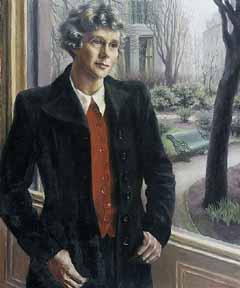Stella Bowen : Art, Love and War
- Periods:
- To England
- An artist's journey
- Inner worlds
- The return to England
- The war years
Period: The war years

Theaden in Kensington
painted in London, 1946
oil on canvas 91.6 x 76.5 cm
signed l.r., oil “STELLA BOWEN”, not dated
private collection
Theaden Brocklebank (1897–1960) was named after the family property near Kyneton in Victoria. She met her future husband, the historian William Keith Hancock, at the University of Melbourne, but the couple spent most of their married life in England. Hancock’s academic projects also took them across Europe and the British Commonwealth, allowing Theaden to develop her natural interest in art and culture.
During the Second World War, Theaden became a producer with the Pacific service of the BBC, one of the few women at the time to hold such a high level position. She arranged for Stella Bowen to record regular talks for Australian audiences about her wartime experiences. These were instrumental in Bowen’s appointment as an official war artist.
After the war the Hancocks made a home in London, and Theaden started training as an artist. They finally moved back to Australia in 1957.
Paintings
- Julia
- The house opposite
- Flight from reason
- Embankment gardens
- Admiral Sir Ragnar Colvin
- Bomber crew
- Bombing up a Lancaster for Wing Commander Douglas
- Remains of a flying bomb
- Group Captain Hughie Edwards
- D-Day, 0300 hours, interrogation hut
- Flying Officer Frederick Syme, Sunderland captain
- Pilot Officer Ronald Warfield
- A Sunderland crew comes ashore at Pembroke Dock (F. Syme, Ron Warfield, Ron Tyson, Eric Genders, Charlie Martin, Spud Murphy, Bob Meade, Merv Pike, Jock Beattie, Curly Rowland and John Bishop)
- At the Churchill Club, large and small worlds
- RAAF airmen at Mongewell Park Medical Rehabilitation Unit
- Private, Gowrie House
- Repatriated prisoner of war is processed
- Brigadier George Langley
- Reception desk at Gowrie House, Eastbourne
- Theaden in Kensington
- [Flowers in a green Norwegian pot]